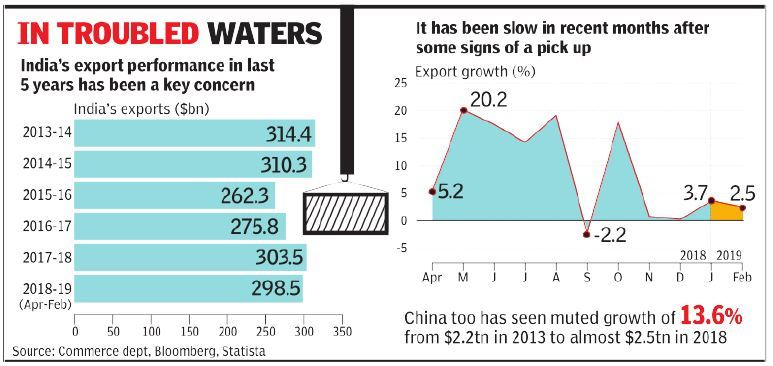Indian Economy
Promoting Export Dynamism
- 15 Oct 2020
- 8 min read
This article is based on “The domestic market mirage” which was published in The Indian Express on 15/10/2020. It talks about the importance of promotion of exports in sustaining long-term economic growth.
In the event of combating slowdown in Indian economy, the government of India launched the Atma-Nirbhar Abhiyaan. The policy of Atma-nirbhar is an attempt to reorient the economic structure towards ensuring “self-sufficiency”.
Under this, the government encourages citizens to buy Indian, and the setting up of targets towards building self-reliance in certain sectors. Apart from it, the Abhiyan also encourages more public spending, tax cuts to boost private consumption and private investment, and/or financial sector reform to boost private investment.
However, these initiatives have their own limitations. Therefore, as India contemplates Atma nirbharta, the economic policy should also strive to promote export dynamism and propel Indian economy to the path of long term sustained economic growth.
Exports and Economic Growth Relation
- All the evidence across the world and in India has shown that rapid and sustained economic growth requires export dynamism.
- Pre-1991, a 3.5% growth rate was associated with export growth of about 4.5%.
- However, India’s GDP growth of over 6% after 1991 was associated with real export growth of about 11%.
- Also, growth rates of developing countries reflect that it is difficult to achieve quick, sustained, and high rates of economic growth, by solely focusing on domestic demand/consumption-led growth.
- Moreover, if domestic producers are competitive internationally, they will be competitive domestically and domestic consumers and firms will also benefit. However, the reverse is not true i.e. being competitive only domestically is no guarantee of efficiency and low cost.
Issues in Current Economic Policies
- Limited Domestic Consumption: Government seeks to promote consumption-led growth, but consumption growth will be limited by the fact that household debt has grown rapidly in the last few years.
- Consumption can grow only if incomes grow and income is related to employment status of the people which has been showing a declining trend in India for the past many years..
- Limitation of Public Expenditure: Government has resorted to increased public spending to combat the economic slowdown triggered by Covid-19 pandemic.
- However, post-Covid, India’s debt has been expected to rise from about 70% of GDP to about 85-90% and fiscal deficit is likely to be in the double-digit range.
- Thus, the fiscal space for spending will be severely limited both because of high levels of deficits and indebtedness.
- Limitation of Expansionary Monetary Policy: India may well have scope for expansionary fiscal policy in the short run but not as a medium run growth strategy.
- This is because India’s interest rates are not at zero and are unlikely to be so because of persistent inflation.
- Therefore, India’s borrowing is still considered risky which can be reflected in recent downgrading of ratings.
Reasons for India’s Underperformance in Exports
- Low Level of Participation in Global Value Chains (GVCs): India’s participation in GVCs has been low compared to the major exporting nations in East and Southeast Asia.
- On the contrary, export growth of capital intensive products from China has been mainly driven by its participation in the GVCs.
- China’s export promotion policies since the 1990s have relied heavily on a strategy of integrating its domestic industries within the GVCs.
- Low Market Penetration in High-Income Countries: With low participation in GVCs have resulted in a disproportionate shift in India’s geographical direction of exports from traditional rich country markets to other destinations like African countries.
- Specialization versus Diversification: Indian exports is characterised by high diversification combined with low specialization in exports.
- This implies that India is spreading its exports thinly over many products and partners, leading to its lacklustre performance compared to countries like China.
- Domestic Factors: The factors like lacklustre infrastructure, complex land and labour markets have impeded the creations of conditions for Indian companies to compete in global markets.
Way Forward
- Trade Liberalisation: India needs to raise its share in world trade beyond 2 per cent. Doing so requires greater trade liberalisation. It will require signing of more free trade agreements.
- Therefore, India wants to access developed countries markets, it should be willing to open its markets also.
- For example, in the context of trade with Europe, it still imposes high duties on India’s exports which disadvantages India. Europe will only be willing to sign such an agreement if India is willing to open its markets like automotives.
- Promoting Ease of doing Business: Export success will also require genuine easing of costs of trading and doing business in India.
- Thus, a more appropriate policy response is to focus on boosting competitiveness — building infrastructure, ensuring cheap power, reforming land and labour markets, and creating conditions for companies to compete in global markets.
- Becoming Part of GVCs: India should be striving to embed itself in global value chains.
- If India wants to become a major exporter, it should specialize more in the areas of its comparative advantage and achieve significant quantity expansion.
- Policy Stability: In the post Covid world, multinational companies in order to hedge against supply chain disruptions will look to shift away from China.
- Therefore, in order to attract GVCs India should provide policy stability.
Conclusion
For a long-term sustained economic growth, India needs to have a remarkable export performance. This will be driven by a set of interrelated factors viz. a high level of participation in GVCs; a high degree of specialization in labour-intensive production activities; large scale in the chosen sectors of specialization; and a high level of export penetration in traditional rich countries.
|
Drishti Mains Question |
This editorial is based on “Readying the ground” which was published in The Financial Express on October 14th, 2020. Now watch this on our Youtube channel.





